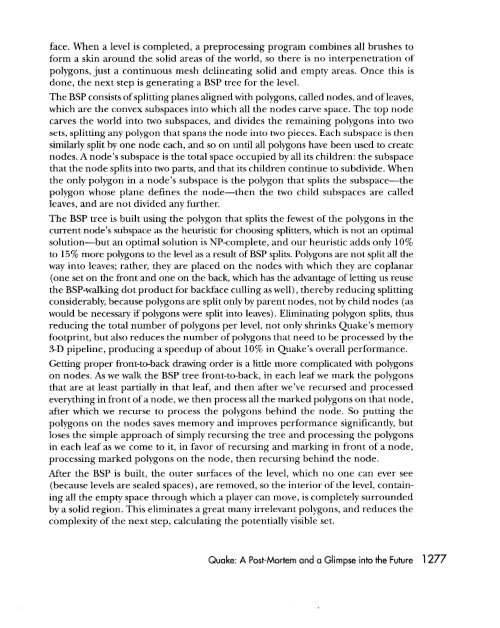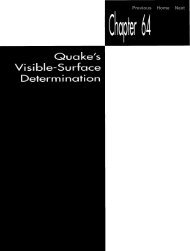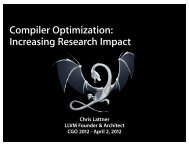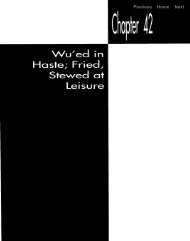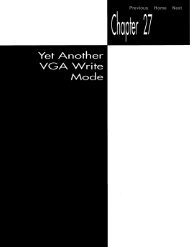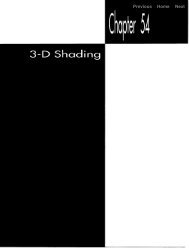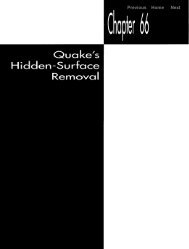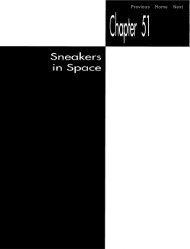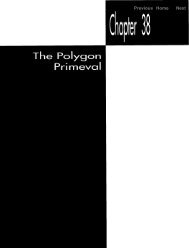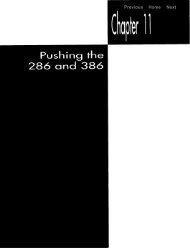quake: a post-mortem and a glimpse into the future
quake: a post-mortem and a glimpse into the future
quake: a post-mortem and a glimpse into the future
You also want an ePaper? Increase the reach of your titles
YUMPU automatically turns print PDFs into web optimized ePapers that Google loves.
face. When a level is completed, a preprocessing program combines all brushes to<br />
form a skin around <strong>the</strong> solid areas of <strong>the</strong> world, so <strong>the</strong>re is no interpenetration of<br />
polygons, just a continuous mesh delineating solid <strong>and</strong> empty areas. Once this is<br />
done, <strong>the</strong> next step is generating a BSP tree for <strong>the</strong> level.<br />
The BSP consists of splitting planes aligned with polygons, called nodes, <strong>and</strong> of leaves,<br />
which are <strong>the</strong> convex subspaces <strong>into</strong> which all <strong>the</strong> nodes carve space. The top node<br />
carves <strong>the</strong> world <strong>into</strong> two subspaces, <strong>and</strong> divides <strong>the</strong> remaining polygons <strong>into</strong> two<br />
sets, splitting any polygon that spans <strong>the</strong> node <strong>into</strong> two pieces. Each subspace is <strong>the</strong>n<br />
similarly split by one node each, <strong>and</strong> so on until all polygons have been used to create<br />
nodes. A node’s subspace is <strong>the</strong> total space occupied by all its children: <strong>the</strong> subspace<br />
that <strong>the</strong> node splits <strong>into</strong> two parts, <strong>and</strong> that its children continue to subdivide. When<br />
<strong>the</strong> only polygon in a node’s subspace is <strong>the</strong> polygon that splits <strong>the</strong> subspace-<strong>the</strong><br />
polygon whose plane defines <strong>the</strong> node-<strong>the</strong>n <strong>the</strong> two child subspaces are called<br />
leaves, <strong>and</strong> are not divided any fur<strong>the</strong>r.<br />
The BSP tree is built using <strong>the</strong> polygon that splits <strong>the</strong> fewest of <strong>the</strong> polygons in <strong>the</strong><br />
current node’s subspace as <strong>the</strong> heuristic for choosing splitters, which is not an optimal<br />
solution-but an optimal solution is NP-complete, <strong>and</strong> our heuristic adds only 10%<br />
to 15% more polygons to <strong>the</strong> level as a result of BSP splits. Polygons are not split all <strong>the</strong><br />
way <strong>into</strong> leaves; ra<strong>the</strong>r, <strong>the</strong>y are placed on <strong>the</strong> nodes with which <strong>the</strong>y are coplanar<br />
(one set on <strong>the</strong> front <strong>and</strong> one on <strong>the</strong> back, which has <strong>the</strong> advantage of letting us reuse<br />
<strong>the</strong> BSP-walking dot product for backface culling as well), <strong>the</strong>reby reducing splitting<br />
considerably, because polygons are split only by parent nodes, not by child nodes (as<br />
would be necessary if polygons were split <strong>into</strong> leaves). Eliminating polygon splits, thus<br />
reducing <strong>the</strong> total number of polygons per level, not only shrinks Quake’s memory<br />
footprint, but also reduces <strong>the</strong> number of polygons that need to be processed by <strong>the</strong><br />
3-D pipeline, producing a speedup of about 10% in Quake’s overall performance.<br />
Getting proper front-toback drawing order is a little more complicated with polygons<br />
on nodes. As we walk <strong>the</strong> BSP tree front-to-back, in each leaf we mark <strong>the</strong> polygons<br />
that are at least partially in that leaf, <strong>and</strong> <strong>the</strong>n after we’ve recursed <strong>and</strong> processed<br />
everything in front of a node, we <strong>the</strong>n process all <strong>the</strong> marked polygons on that node,<br />
after which we recurse to process <strong>the</strong> polygons behind <strong>the</strong> node. So putting <strong>the</strong><br />
polygons on <strong>the</strong> nodes saves memory <strong>and</strong> improves performance significantly, but<br />
loses <strong>the</strong> simple approach of simply recursing <strong>the</strong> tree <strong>and</strong> processing <strong>the</strong> polygons<br />
in each leaf as we come to it, in favor of recursing <strong>and</strong> marking in front of a node,<br />
processing marked polygons on <strong>the</strong> node, <strong>the</strong>n recursing behind <strong>the</strong> node.<br />
After <strong>the</strong> BSP is built, <strong>the</strong> outer surfaces of <strong>the</strong> level, which no one can ever see<br />
(because levels are sealed spaces), are removed, so <strong>the</strong> interior of <strong>the</strong> level, containing<br />
all <strong>the</strong> empty space through which a player can move, is completely surrounded<br />
by a solid region. This eliminates a great many irrelevant polygons, <strong>and</strong> reduces <strong>the</strong><br />
complexity of <strong>the</strong> next step, calculating <strong>the</strong> potentially visible set.<br />
Quake: A Post-Mortem <strong>and</strong> a Glimpse <strong>into</strong> <strong>the</strong> Future 1277


